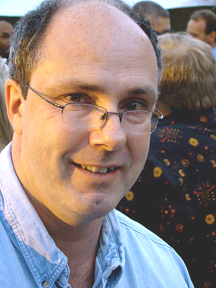|
|

Richard Allsopp
|
 |
| Affiliation: |
School of Medicine, Institute for Biogenesis Research |
| Position: |
Assistant Professor |
| Degree: |
PhD |
| Phone: |
(808) 692 1412 |
| Fax: |
(808) 692 1951 |
| Email: |
allsopp@hawaii.edu |
| Address: |
651 Ilalo St., BSB 163B, Honolulu, HI 96813 |
|
Research projects:
Analysis of the role of telomerase in stem cells and human diseases.
Description of research:
Telomerase is required to maintain telomeres, the protective cap at the end of chromosomes, in all eukaryotic cells. In mammals, including humans, some somatic cells in adults lack telomerase, and as a consequence, telomeres gradually short during cell division and as a function of age. Stem cells are required to replenish dead or damaged cells throughout life, and therefore telomerase is thought to play an important role in stem cell survival. While telomerase is indeed detectable in many types of human stem cells (unlike mature somatic cells), in some cases, such as in the blood, there isn't sufficient telomerase to maintain telomere length as these cells divide, and as a consequence, telomeres shorten in all blood cells during aging. On the other hand, male germ cells do have sufficient telomerase to thwart telomere loss during aging. one of the primary goals in my lab is to get a better understanding as to how telomerase activity levels are regulated in different types of stem cells. Recently, we have performed a screen for transcriptional regulators in embryonic stem cells and found that the transcription factor Hypoxia Inducible Factor 1 alpha (Hif1alpha) is essential for maintainence of functional levels of telomerase in these cells. One of the future goals of our work is get a better understanding as to the role of Hif1alpha in regulating telomerase in other types of stem cells. My lab is also interested in evaluating the therapeutic potential of using stem cells, particularly stem cells derived from the bone marrow, which is a pracxtical source of stem cells in adults, to treat cardiac infarcts using a murine model system.
Selected publications:
- Allsopp, R. C., Vaziri, H., Patterson, C., Goldstein, S., Younglai, E. V., Futcher, A. B., Greider, C. W. and Harley, C. B. Telomere length predicts replicative capacity of human fibroblasts. 1992. Proc. Nat. Acad. Sci. U. S. A. 89, 10114-10118.
- Harley, C. B., Vaziri, H., Counter, C. and Allsopp, R. Telomere hypothesis of cell aging. 1992. Exp. Geront. 27, 375-382.
- Vaziri, H., Dragowska, W., Allsopp, R. C., Thomas, T. E., Harley, C. B. and Lansdorp, P. Evidence for a mitotic clock in primative blood stem cells: Loss of telomeric DNA with age. 1994. Proc. Nat. Acad. Sci. U.S.A. 91, 9857-9860.
- Allsopp, R. C. and Harley, C. B. Evidence for a critical telomere length in senescent human fibroblasts. 1995. Exp. Cell Res. 219, 130-136.
- Allsopp, R. C., Chang, E. C., Kashefi-Aazam, M., Rogoev, E. and Harley, C. B. Telomere shortening is associated with cell division in vitro and in vivo. 1995. Exp. Cell Res. 220, 194-200.
- Greenberg, R., Allsopp, R., Chin, L., Morin, G. and dePinho, R. Expression of mouse telomerase reverse transcriptase during development, differentiation and proliferation. 1998. Oncogene, 16, 1723-30.
- Allsopp, R., Cheshier, S. and Weissman, I.L. Telomere shortening accompanies increased cell cycle activity during serial transplantation of hematopoietic stem cells. 2001. J. Exp. Med. 193, 917-924.
- Wagers, A.J., Allsopp, R.C. and Weissman, I.L. Changes in integrin expression are associated with altered homing properties of Lin(-/lo)Thy1.1(lo)Sca-1(+)c-kit(+) hematopoietic stem cells following mobilization by cyclophosphamide/granulocyte colony-stimulating factor. 2002. Exp Hematol. 30, 176-185.
- Allsopp, R. and Weissman, I.L. Replicative senescence of hematopoietic stem cells during serial transplantation: does telomere shortening play a role? 2002. Oncogene. 13, 3270-3273.
- Allsopp, R., Cheshier, S. and Weissman, I.L. Telomerase activation and rejuvenation of telomere length in activated of T cells derived from hematopoietic stem cells following serial transplantation. 2002. J. Exp. Med. 196, 1427-33.
- Allsopp, R., Morin, G., DePinho, R., Harley, C. and Weissman, I.L. Telomerase is required to slow telomere shortening and extend replicative lifespan of HSC during serial transplantation. 2003. Blood. 102, 517-20.
- Allsopp, R., Morin, G., DePinho, R., Harley, C. and Weissman, I.L. Effect of TERT over-expression on the long-term transplantation capacity of hematopoietic stem cells. 2003. Nat. Med. 9, 369-71.
- Coussens, M., Yamazaki, Y., Moisyadi, S., Suganuma, R., Yanigimachi, R. and Allsopp, R. Regulation and effects of modulation of telomerase reverse transcriptase expression in primordial germ cells during development.2006. Biol. Reprod. 75, 785-791.
- Allsopp, R., Shimoda, J., Easa, D., and Ward, K. Long telomeres in the mature human placenta. 2007. Placenta. 28, 324-7.
- Narala S., Allsopp, R. et al. SIRT1 acts as a nutrient-sensitive growth suppressor and its loss is associated with increased AMPK and telomerase activity. 2008. Mol Cell Biol. 19, 1210-19.
- Coussens M, Maresh G, Yanagimachi R, Maeda G, and Allsopp R. Sirt1 Deficiency attenuates spermatogenesis and germ cell function. 2008. PLoS ONE. 13, e1571-74.
- Davy, P and Allsopp R. Balancing out the ends during iPSC nuclear reprogramming. 2009. Cell Stem Cell. 4, 95-96.
- Davy P, Nagata M, Bullard P, Fogelson NS, Allsopp R. 2009. Fetal growth restriction is associated with accelerated telomere shortening and increased expression of cell senescence markers in the placenta. Placenta, In Press.
- Squires J, Davy P, Berry M, Allsopp R. 2009. Attenuated expression of SECIS binding protein 2 causes loss of telomeric reserve without affecting telomerase. Exp Geront. In Press.
- Meznikova M, Allsopp R, Erdmann N, Weissman I, Harrington LH. 2009. Telomere re-equilibration after prolonged telomerase heterozygosity in mice. Disease Models and Mechanisms. In Press.
|
|



